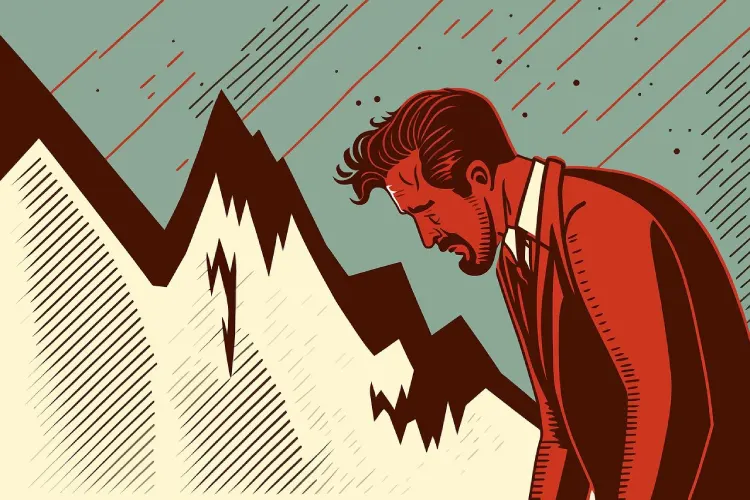The wild world of bear markets. These financial storms are like the ultimate rollercoaster ride for your money, and trust me, they’re not for the faint of heart.
Picture a bear market, officially known as a period where the stock market takes a nosedive of 20% or more from its peak, and it sticks around for a gut-wrenching 60 days or more. Yeah, it’s like that sinking feeling in the pit of your stomach when you see your ice cream cone tumble to the ground on a scorching summer day.
These bear markets don’t just pop in and out like a quick summer shower. No, they tend to hang around, causing financial havoc for a little over a year on average. It’s like enduring a seemingly never-ending winter that just won’t quit.
Now, let me drop a truth bomb on you: bear markets are like the ominous storm clouds that roll in before the full-blown economic tornado hits. They’re like Mother Nature’s way of saying, “Get ready, folks, because a storm’s a-brewin’!”
Why do bear markets come and go faster than their big, bad brother, the recession? Well, it’s all about timing. You see, the stock market is like that savvy friend who always knows the latest gossip before it even hits the headlines. It reacts to what it thinks will happen in the future. On the other hand, recessions are like your grandpa’s old vinyl records – they take a while to spin up and get going. So, you might be wondering, “What on earth should we expect during the three stages of a bear market?”
Stage 1: The Sell-Off
The journey starts oh-so-gradually, just like the first rays of dawn creeping over the horizon after a night of restless anticipation. We’re soaring high, basking in the glory of all-time stock market highs. It’s like being on cloud nine. But then, something peculiar happens. The pace quickens, and a whisper of transparency begins to materialize. The euphoria we’ve been riding suddenly shows signs of faltering. The “buy the dip” strategy, a tried-and-true mantra for years, starts to lose its shine.
Every time the market takes a dip, the rebound isn’t quite what it used to be. It’s like trying to catch lightning in a bottle, and each bounce gets lower, like a rollercoaster losing altitude with each thrilling swoop. It’s like the music has stopped, and you’re left without a chair in the game of musical chairs. That’s when FOMO, or Fear of Missing Out, kicks in big time. People scramble to buy the initial dip, hoping for a miracle bounce. And sometimes, just sometimes, they get that adrenaline-pumping, heart-racing bounce.
Each of those sharp bounces is just a fleeting moment of joy before the market takes another nosedive. And here’s where it gets real: the robust buying we once knew starts to thin out. With each new bounce, it climbs a little less high. It’s like climbing a mountain where the peak keeps getting further away. That’s when you know, my friend, the downhill journey has begun.
The market drops deeper and deeper, making lower lows. It’s like a race to the bottom, and the finish line is nowhere in sight. Panic sets in like an unwelcome guest crashing your party. The magnitude of the selling is on the rise, and investors start to break out in a cold sweat. It’s like a horror movie, and you can’t look away. Then come the bear market headlines, ominous and foreboding, taking over the evening news. They sound the alarm, warning of an impending recession. It’s as if a thunderstorm is brewing, and you’re not sure if you’re prepared for the deluge. Workers anxiously huddle over their retirement portfolios, hoping to find some shelter from the storm. Fund outflows increase, like a stampede out of a burning building.
Buyers, those brave souls who once charged headfirst into the market, suddenly go on strike. They’re like a tap that’s run dry, and the well of confidence has seemingly dried up. The name of the game becomes “risk-off,” and it’s like a universal retreat across the board. Each attempt to bounce seems to end in disappointment, ushering in new lows like an unwelcome guest.
And then, the unthinkable happens. Panic takes center stage, a wild dance of uncertainty and fear. The selling is so sharp that it’s like falling off a cliff. Margin calls and forced liquidations echo like a deafening cacophony, causing the market to experience large gaps down, like a ship that’s hit an iceberg.
Now, here’s the kicker: good news becomes bad news. It’s like living in an upside-down world where the rules no longer apply. Bad news, on the other hand, is catastrophic for stocks. It’s like tossing a lit match into a tinderbox. The selling reaches a fever pitch, like a whirlwind that’s impossible to escape. You can feel the tension in the air, thick as a thunderstorm about to unleash its fury.
In the midst of all this chaos, a near-term bottom is finally found, like a moment of respite in the eye of the storm. But it’s not over yet; this is just one chapter in the tumultuous tale of the stock market.
Stage 2: The Reversion Bounce
Picture that you are in the wild, wild world of the stock market, and things have taken a dramatic turn. The stage we’re diving into now is no ordinary stage; it’s like the calm after a storm, where a glimmer of hope emerges after a new low is hit. This is where the rollercoaster ride of emotions truly kicks in.
You see, it’s not just any rebound; it’s a rebound that’s got some grit to it. The bulls, those brave souls who bet on the market, they’ve been through the wringer. They’ve seen the market hit rock bottom more times than they care to remember, and it’s left them feeling a bit skeptical. They’re not ready to dive back in just yet. But here’s where things get interesting. Against all odds, these rebounds start to stick. It’s like watching a phoenix rise from the ashes. The market finds its footing, and those wild bounces miraculously start holding onto their gains. It’s like the market is saying, “I’m not going down without a fight.”
Buyers, the courageous folks who see opportunity even in the face of uncertainty, start stepping up their game. They gobble up those sell-offs like a kid in a candy store. The stock market? Well, it’s not exactly thrilled, but it can’t help but begrudgingly inch its way up.
And then it happens. The bulls, those same weary warriors who’ve weathered the storm, they begin to smile. They start to regain their confidence and muster. It’s like a wave of hope washes over them. They’re ready to chase those entry points, and they’re even willing to pay a little extra for a ticket to the steady rally.
Why, you ask? Because they believe that this time, the bottom is finally here. Every time the market takes a dip, it’s like a staircase to success, hitting a higher floor with each step. And you know what that does? It motivates the buyers to get in on the action, to catch that last train to higher ground.
It’s a story of resilience, of investors who refuse to give up, even when the odds are stacked against them. It’s a tale of hope, a tale of the stock market that, in its own way, defies the odds and keeps on grinding higher.
Stage 3: The Capitulation and a Final Drop
As we dive into the final stage of this financial rollercoaster, you’ve got the bulls waving their pom-poms high, chanting for the market’s triumphant return to its former glory. They’re brimming with confidence, convinced that the good times are just around the corner. But, hold on to your hat, because we’ve seen this before – it’s like a case of déjà vu.
Just as hope begins to shine through, the buyers’ enthusiasm starts to flicker. The sellers reappear, but this time, they’re not swinging as hard. The market, stubborn as ever, keeps edging lower, shrugging off those brief bounces that like to play tricks on us. It’s almost as if complacency has moved in for a lengthy stay, like an unwelcome houseguest.
The market seems content in this lower realm, where the occasional rally is just a tease, a false promise. It’s a cruel dance where the lows gradually creep lower, and then, one day, they shatter through the floor. Panic grips the scene as the market reaches new depths, and even the die-hard bulls are finally waving the white flag.
The fear is real; it’s palpable. People start to scramble, fearing the market will plunge even deeper into the abyss. The media is all over it, painting a gloomy picture, screaming, “The sky is falling!” In the midst of this chaos, we witness indiscriminate selling, as investors toss out the good with the bad. It’s like throwing the baby out with the bathwater – a hasty, panicked move that’s often driven by raw emotion.
But then, something strange happens. In the midst of the hysteria, the market hits new bear market lows, yet this time, it’s like the market says, “Enough is enough.” It finds a floor, a bottom that actually holds. The only folks still hanging on to their positions are those with nerves of steel, the long-term investors who aren’t easily swayed, or maybe they just don’t care anymore. Their portfolios have already taken such a hit that it hardly seems to matter now.
It’s only when you look in the rearview mirror that you see it – the subtle signs of a rally, a U-shaped bottom forming if the selling has been a prolonged ordeal. It’s a different story from the V-shaped bottoms, those lightning-fast plunges we witnessed during the 2020 pandemic sell-off.
But here’s the silver lining: history reminds us that all bear markets eventually come to a close. And when they do, they often usher in roaring bull markets, ready to take the stage. But remember, this nugget of wisdom applies mainly to the benchmark indices, not necessarily every individual stock

 Propel Your Product Into the World Now!
Propel Your Product Into the World Now!